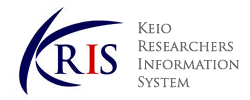-
Affiliation
-
Faculty of Science and Technology, Department of Applied Chemistry ( Yagami )
-
Position
-
Associate Professor

KEIO RESEARCHERS INFORMATION SYSTEM |
Details of a Researcher
このページはJavascriptを使用しています。すべての機能を使用するためにはJavascript を有効にする必要があります。
Hiruta, Yuki
|
|
|
Keio University, Graduate School of Science and Technology, Assistant Professor
Japan Society for the Promition of Science, Research Fellowship for Young Scientists (DC2)
Keio University, Faculty of Pharmacy, Assistant Professor
Keio University, Faculty of Science and Technology, Senior Assistant Professor
Keio University, Faculty of Science and Technology, Associate Professor
Keio University, Faculty of Science and Technology, Department of Applied Chemistry
University, Graduated
Keio University, Graduate School of Science and Technology, School of Integrated Design Engineering
Graduate School, Completed, Master's course
Keio University, Graduate School of Science and Technology, School of Integrated Design Engineering
Graduate School, Completed, Doctoral course
Shindo Y., Ikeda Y., Hiruta Y., Citterio D., Oka K., Methods in Molecular Biology, 2021
Imaging Ligand-Driven PPAR Activities Using Single-Chain Bioluminescent Probes
Kim, SB; Furuta, T; Kamiya, G; Maki, SA; Orioka, M; Watanabe, R; Hiruta, Y; Thangudu, S; Natarajan, A; Paulmurugan, R
ACS OMEGA 10 ( 30 ) 33850 - 33861 2025.08
ISSN 2470-1343
Current advances in separation chemistry for antibody purification and analysis
Deol S., Matsuda Y., Hiruta Y.
Analytical Sciences 41 ( 5 ) 653 - 666 2025.05
Research paper (scientific journal), Joint Work, Last author, Corresponding author, Accepted, ISSN 09106340
Bioluminescence readout lateral flow immunoassay using nanobody targeting aflatoxin B1
Takahashi, S; Hiruta, Y; Citterio, D
ANALYST 150 ( 8 ) 1563 - 1570 2025.04
Research paper (scientific journal), Joint Work, Accepted, ISSN 0003-2654
Origami Paper-Based Immunoassay Device with CRISPR/Cas12a Signal Amplification
Suzuki, H; Tong, GD; Nath, P; Hiruta, Y; Citterio, D
ACS SENSORS 10 ( 3 ) 1811 - 1821 2025.03
Research paper (scientific journal), Joint Work, Accepted, ISSN 2379-3694
The latest developments of near-infrared fluorescent probes from NIR-I to NIR-II for bioimaging
Kuronuma, Y; Watanabe, R; Hiruta, Y
ANALYTICAL SCIENCES 41 ( 6 ) 737 - 757 2025.02
Research paper (scientific journal), Joint Work, Last author, Corresponding author, Accepted, ISSN 0910-6340
Development of disease biomarker-selective photoacoustic imaging probes
Hiruta, Yuki
福澤諭吉記念慶應義塾学事振興基金事業報告集 (福澤基金運営委員会) 2023
Hiruta, Yuki
科学研究費補助金研究成果報告書 2021
Development of tumor self-accumulating functionalized theranostics nanoplatform
Hiruta, Yuki
科学研究費補助金研究成果報告書 2021
Optical imaging technology for manipulating and observing intracellular magnesium ions
Hiruta, Yūki
福澤諭吉記念慶應義塾学事振興基金事業報告集 (福澤基金運営委員会) 2020
Development of dual pH-responsive drug delivery career by the logical design of polymer
Hiruta, Yuki
科学研究費補助金研究成果報告書 2016
レシオメトリック型低親和性カルシウムイオン蛍光プローブによる細胞内イメージング
蛭田勇樹
[Domestic presentation] 日本分析化学会第74年会,
Oral presentation (general)
生体分子・細胞との相互作用を制御する刺激応答性高分子材料の開発
蛭田勇樹
[Domestic presentation] 第71回高分子研究発表会(神戸),
Oral presentation (invited, special)
ペプチドミメティック分子設計pH応答性カラム充填剤による抗体精製
蛭田勇樹
[Domestic presentation] 第32回クロマトグラフィーシンポジウム,
Oral presentation (general)
化学平衡を活用した蛍光プローブの創製と生体イメージングへの応用
蛭田勇樹
[Domestic presentation] 慶應有機化学若手シンポジウム,
Oral presentation (invited, special)
機能性近赤外光プローブの創製と細胞・生体イメージングへの応用
蛭田勇樹
[Domestic presentation] 日本化学会第105春季年会(2025),
Oral presentation (invited, special)
神経細胞間金属イオン動態を可視化するオールケミカル蛍光イメージング技術の開発
挑戦的研究(萌芽), Principal investigator
ペプチドミメティクス分子設計を基盤とした抗体及び抗体薬物複合体分離精製技術の構築
基盤研究(B), Principal investigator
がんバイオマーカー応答性高分子を基盤とした光セラノスティクスプラットフォーム構築
文部科学省, 日本学術振興会 科学研究費助成事業 国際共同研究加速基金(国際共同研究強化(A)), Principal investigator
生命科学研究を拓く生物発光技術の開発
文部科学省, 日本学術振興会 科学研究費助成事業 基盤研究(B), Coinvestigator(s)
がんバイオマーカー応答性高分子設計を戦略とした光セラノスティクス薬剤の開発
MEXT,JSPS, Grant-in-Aid for Scientific Research, Grant-in-Aid for Scientific Research (C), Principal investigator
ヤングサイエンティスト講演賞
2025.07, 高分子学会 関西支部, 生体分子・細胞との相互作用を制御する刺激応答性高分子材料の開発
Type of Award: Award from Japanese society, conference, symposium, etc.
Award for Encouragement of Research in Chromatographic Sciences
2024.11, The Society for Chromatographic Sciences, Development of column packing materials using functional polymers and application to pharmaceutical analysis
Type of Award: Award from Japanese society, conference, symposium, etc.
Best Poster Award HPLC 2022, San Diego
2022.06
Type of Award: Award from international society, conference, symposium, etc.
Outstanding Reviewer for journal of Materials Chemistry B
2021.03
Type of Award: Award from publisher, newspaper, foundation, etc.
Award for Encouragement of Research in Analytical Chemistry
2020.08, The Japan Society of Analytical Chemistry, Development and application of bioimaging probes based on precision molecular design
Type of Award: Award from Japanese society, conference, symposium, etc.
SEMINAR IN APPLIED CHEMISTRY
2025
PRACTICAL INSTRUMENTAL ANALYSIS
2025
NANO SCALE SCIENCE JOINT SEMINAR
2025
MATERIAL DESIGN SCIENCE JOINT SEMINAR
2025
LABORATORY IN SCIENCE
2025
クロマトグラフィー科学会会員,
高分子学会会員,
日本DDS学会会員,
日本薬学会会員,
日本化学会会員,
生物発光化学発光研究会世話人, 生物発光化学発光研究会
Associate Editor in Analytical Sciences, The Japan Society for Analytical Chemistry
関東支部常任幹事 , 日本分析化学会
化学グランプリ・オリンピック委員会 グランプリ小委員会 委員, 公益社団法人日本化学会
代議員, 日本分析化学会